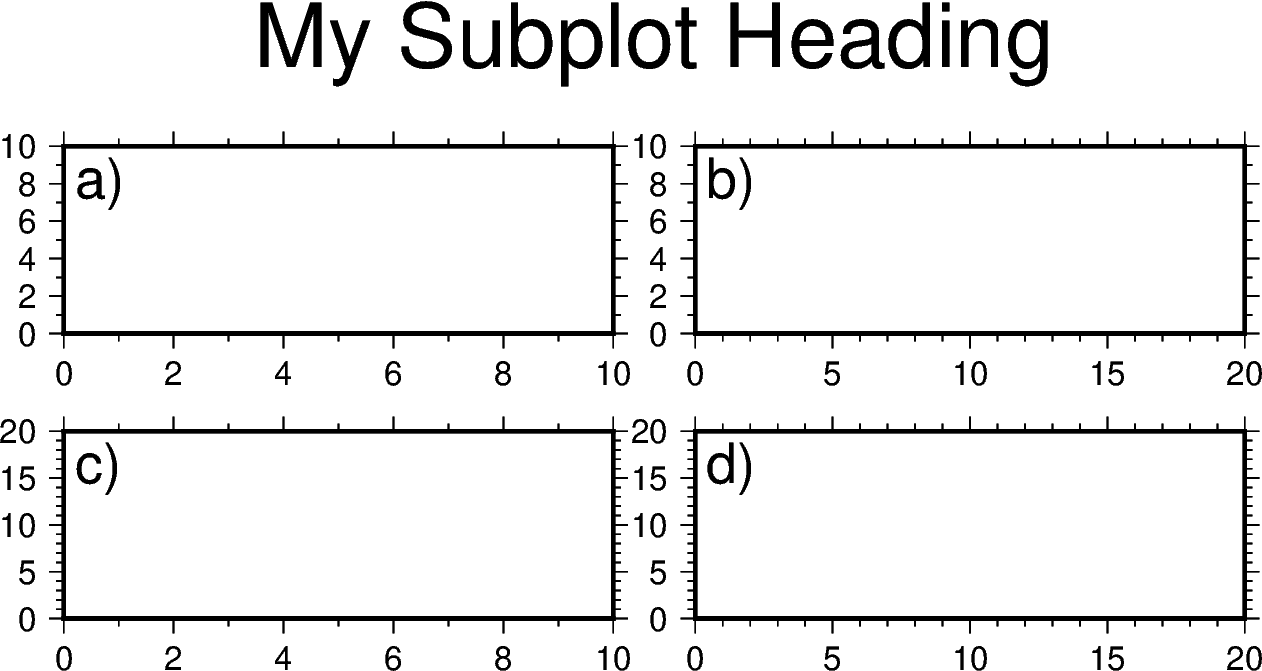
plt.subplot(2, 2, 1)Īdd an overall title to a subplot in matplotlib with the plt.suptitle() function (it stands for ‘super title’). You can add a title to each subplot with the plt.title() function.

SUBPLOT TITLE PLT HOW TO
Now, let’s look at how to add more info to our subplots in matplotib. It’s an easy way to make your plots look great.Ĭheck out the docs more information and arguments that tight_layout in matplotlib accepts. I use plt.tight_layout() in every single plot (without colobars or legends) and I recommend you do as well. Now there is less space between the plots but everything is still readable. It accepts a float in the range and is a fraction of the font size. You can adjust this with the pad keyword. Now there is plenty of space between the plots. Let’s see the most basic example without any labels or titles. Also, note that it does not work too well with legends or colorbars – you’ll see how to work with them later. It’s not perfect but often does a really good job. titles set with plt.title() and plt.suptitle().tick labels set with plt.xticks() and plt.yticks(),.axis labels set with plt.xlabel() and plt.ylabel(),.Matplotlib Tight_Layoutīy calling plt.tight_layout(), matplotlib automatically adjusts the following parts of the plot to make sure they don’t overlap: Thankfully, the matplotlib tight_layout function was created to solve this. You have this ticks problem whenever you create subplots. Plus, you cannot automate them which is annoying for us programmers. Plt.suptitle('Smaller Xticks In A Better Position')īoth these methods work but are fiddly. # Move and decrease size of xticks on all subplots

Plt.suptitle('Transparent Xticks - plt.xticks(alpha=0)') # Make xticks of top 2 subplots transparent move them and decrease their font size with the position and size arguments.make them transparent by setting alpha=0, or.You have a few ways to solve this problem.įirst, you can manually adjust the xticks with the matplotlib xticks function – plt.xticks() – and either: This looks ok but the x-axis labels are hard to read on the top 2 subplots. Let’s look at the default subplot layout and the general outline for your code. I will alternate between including and excluding commas to aid your learning. Thus, the following are equivalent – they both select index 1 from a 3×1 grid. However, the comma between the values is optional, if each value is an integer less than 10. > plt.subplot(nrows=3, ncols=1, index=1)ĪttributeError: 'AxesSubplot' object has no property 'nrows' You cannot pass them as keyword arguments. The arguments for plt.subplot() are positional only. It continues from left-to-right in the same way you read. Unlike everything else in the Python universe, indexing starts from 1, not 0.
SUBPLOT TITLE PLT CODE
The code you write immediately after it is drawn on that subplot. The index is the subplot you want to select. For a 3×1 grid, it’s nrows=3 and ncols=1. If you want a 2×2 grid, set nrows=2 and ncols=2. The first two – nrows and ncols – stand for the number of rows and number of columns respectively. The arguments for plt.subplot() are intuitive: plt.subplot(nrows, ncols, index) # Import necessary modules and (optionally) set Seaborn style Finally, call plt.show() to display your plot. Once all Subplots have been plotted, call plt.tight_layout() to ensure no parts of the plots overlap. Then, select the next subplot by increasing the index by 1 – plt.subplot(3, 1, 2) selects the second Subplot in a 3 x 1 grid. So, plt.subplot(3, 1, 1) has 3 rows, 1 column (a 3 x 1 grid) and selects Subplot with index 1.Īfter plt.subplot(), code your plot as normal using the plt.

I'd like to know if there's a straightforward way to just shift the title directly up a few tens of pixels, so that the chart looks prettier.To create a matplotlib subplot with any number of rows and columns, use the plt.subplot() function. orbit', xy=(Planet.T_day*1.3, r_geo), xytext=(Planet.T_day*1.3, r_geo))Īx.set_ylabel('Orbital radius (km), logarithmic')Īx.set_title('Orbital charts for ' + Planet.N, horizontalalignment='center', verticalalignment='top')Īnd the data is presented fine, but I am having the problem that the figure title is overlapping with the axes labels on the secondary x axis so that it's barely legible (I wanted to post a picture example here, but I don't have a high enough rep yet). I am trying to plot two separate quantities on the same graph using twiny as follows: fig = figure()Īx.plot(T, r, 'b-', T, R, 'r-', T, r_geo, 'g-')Īx.annotate('Approx.


 0 kommentar(er)
0 kommentar(er)
